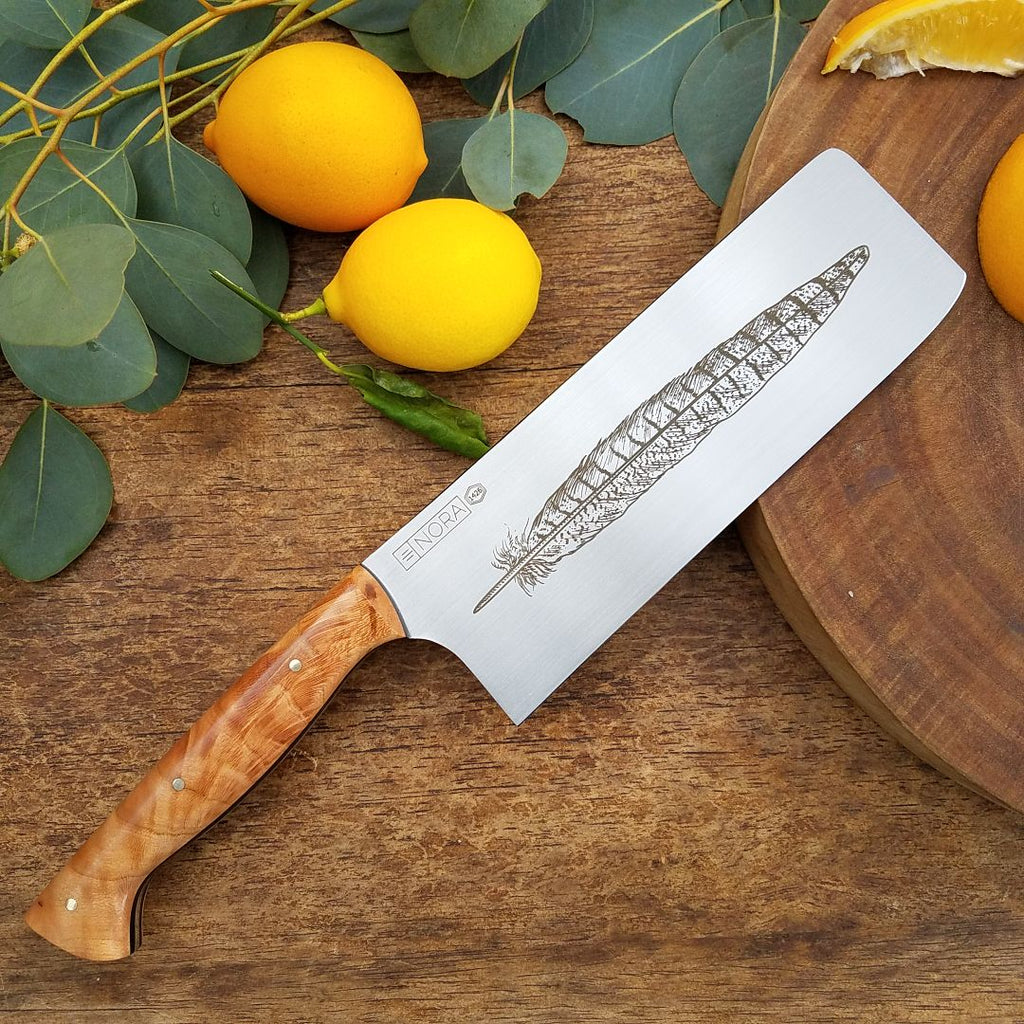
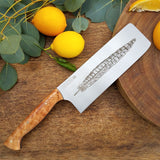

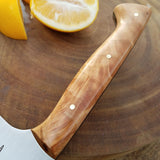
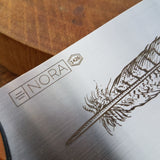

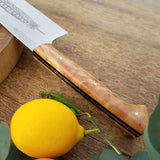


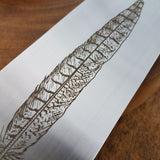
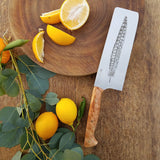


NORA Nakiri #1426 - AEB-L Stainless Steel - Pheasant Feather
$ 389.25
KNIFE HIGHLIGHTS
- Blade Type: Nakiri
- Blade Length: 6.5 Inches
- Total Length: 11.75 Inches
- Handle Style: Western | Right or Left Hand Use
- Steel: AEB-L Stainless Steel
- Handle Materials: Stabilized Flame Cherry Wood, Black G10 liners, Brass Pins
- Rockwell Hardness: 62 HRC
- Grind Type: Full Flat
- This Blade is Ground...
- Thin for Performance (best performance but delicate! No bones, no frozen food, hard squashes, etc. )
- Thick for Durability (tough, built to last for heavy wear-n-tear)
- >>> Mid-Range with Special Geometry (specially ground for food release and glide but blade is kept slightly thicker for durability)
- This Knife Feels...
- Heavy in Hand (hefty, durable)
- Light (nimble, maneuverable)
- >>>Not too heavy, not too light (Switzerland)
GENERAL USES OF THIS KNIFE
NAKIRI
The Nakiri knife is a Japanese style knife that is specifically designed to excel at cutting and prepping vegetables and greens. These blades are very thin and literally fall through food. Because of the thinness, these blades should not be used for cutting through any type of bone or harder objects but you would be surprised at the versatility of the Nakiri. We find we use ours for a wide array of tasks in the kitchen - everything from protein prep to bread.
The blade height is just over 2 inches which is larger than many other Nakiri's but we find it helps keep your knuckles off the board and it works well with many larger vegetables.
HANDLE DESIGN & MATERIALS:
Every one of our knives is handmade, unique and numbered. This NORA is as simple and classic as they come. We took a beautiful piece of stabilized flame cherry wood and we added black G10 liners. The liners help with overall durability of the knife and pins are a classic brass. The look is simple and timeless.
Wood stabilization is an added feature that we offer with our knives and spalted wood, in particular, benefits greatly from stabilization. Wood that is stabilized has been injected with a clear acrylic resin under a vacuum process. Stabilization helps to minimize any cracking, warping, shrinkage and/or expanding of the material. Stabilized wood will not absorb water and is generally impervious to oils.
ENGRAVING:
We've been on a feather kick lately. It started with a peacock feather we did on a different knife and then I glanced at the grain pattern in the wood on this handle and I felt that a feather would work really well with this knife as well. I went with a long pheasant feather which has a sort of classic elegance that I thought would pair well with the beautiful wood. We really love the finished product on this one.
STEEL INFORMATION:
AEB-L STAINLESS STEEL
This knife blade is composed of AEB-L stainless steel which is a high-quality Swedish metal, originally developed for razor blades. Recently, steel suppliers have made this steel available in thicker sheets and it has proven to be an excellent adaptation for the cutlery industry.
AEB-L has a beautiful balance of carbon and chromium and, with proper heat treatment, this steel produces both a very fine edge as well as excellent toughness and edge stability. The fine grain structure also makes this steel very easy to sharpen. We believe it is one of the finest stainless steels available on the market today for use with kitchen knives.
As a side note, there are two things we like to mention about this steel:
1.) This steel responds beautifully to honing and if the knife is honed regularly it should need infrequent sharpening.
2.) AEB-L is a stainless steel but just barely. The higher carbon content in this stainless is what allows it to get a fine edge and higher hardness than other stainless steels but it also has a tendency to sometimes form very fine rust spots on the blade. If this happens, these are easily removed with a green scotch brite pad and usually the rough end of a kitchen sponge will also do the trick.
